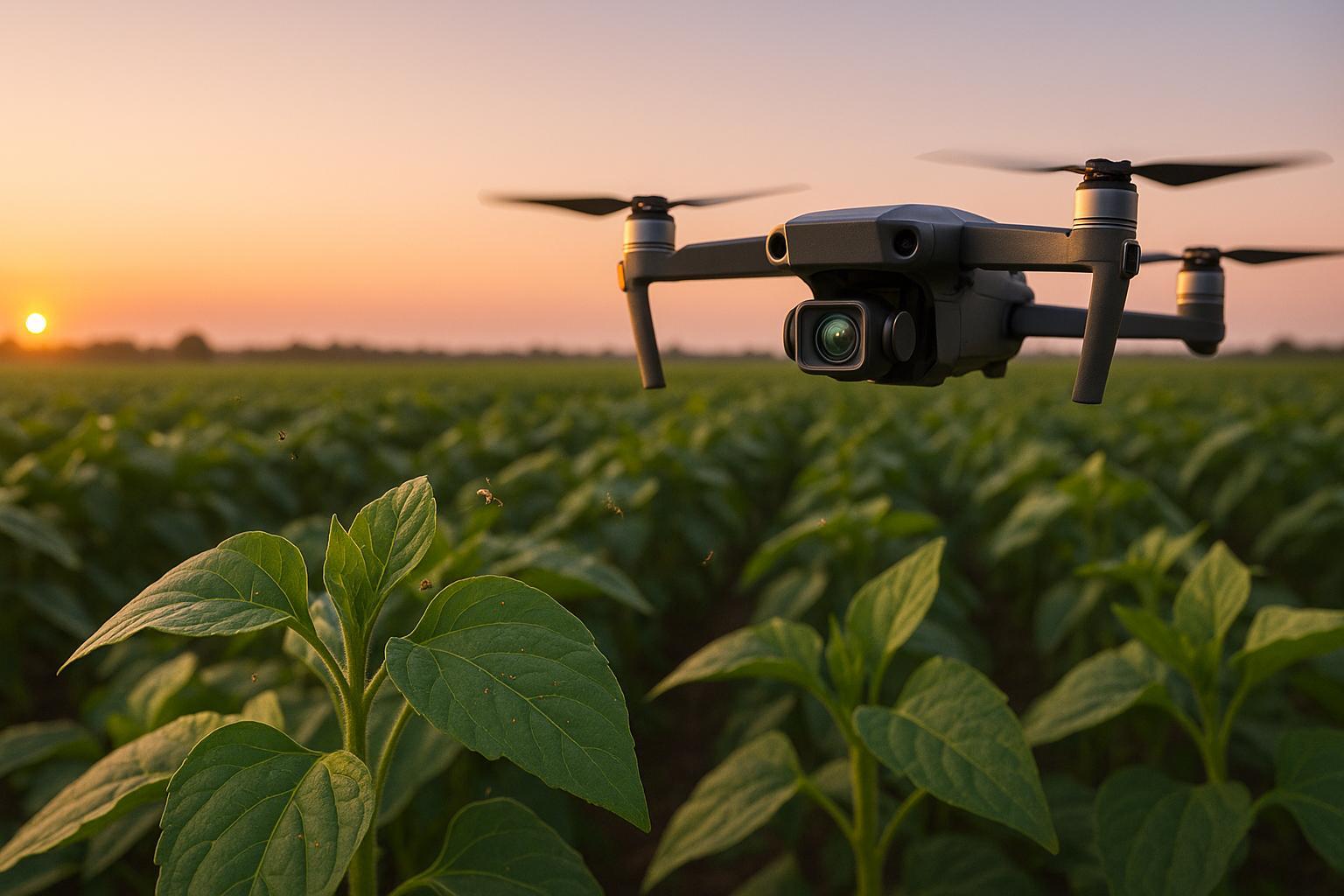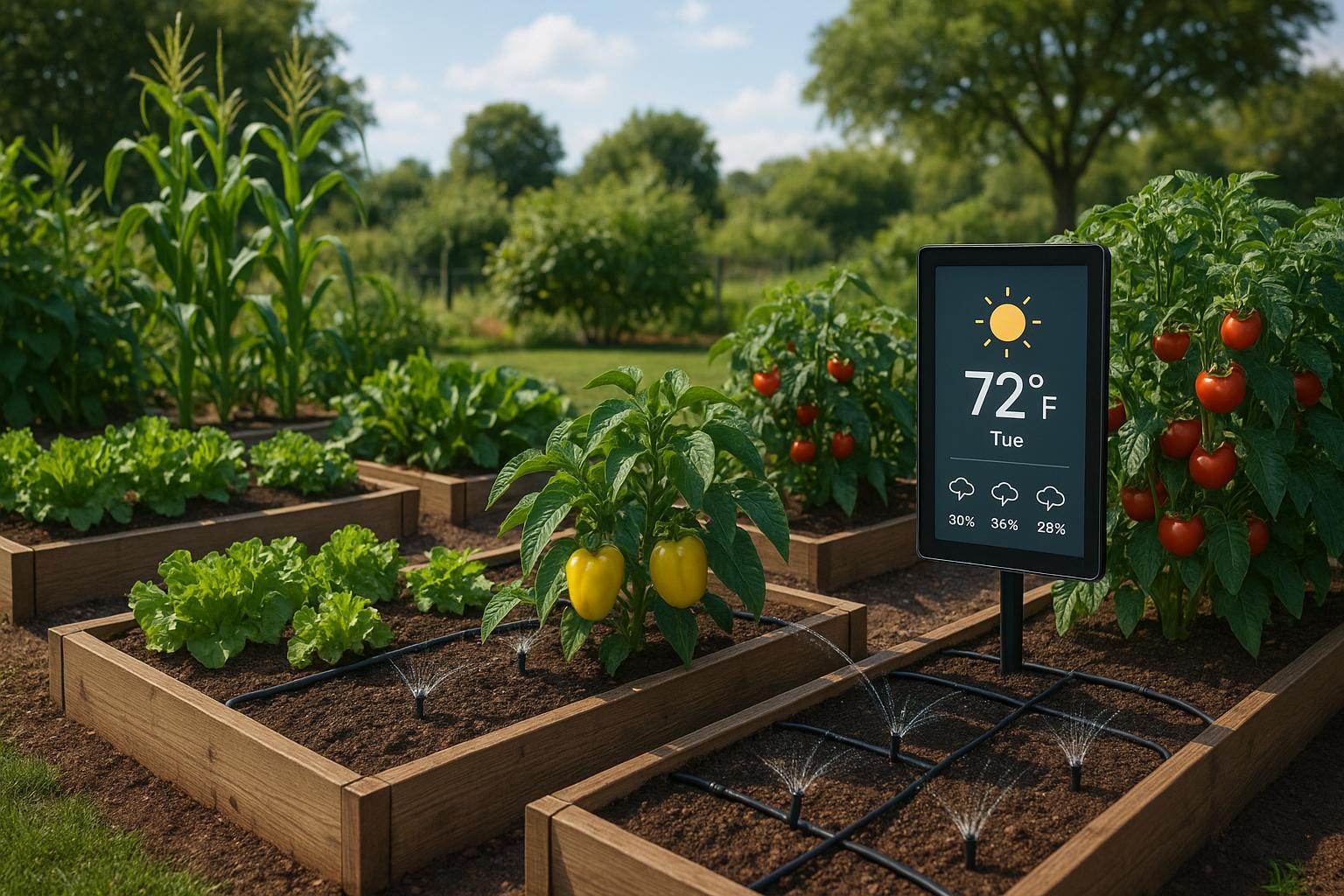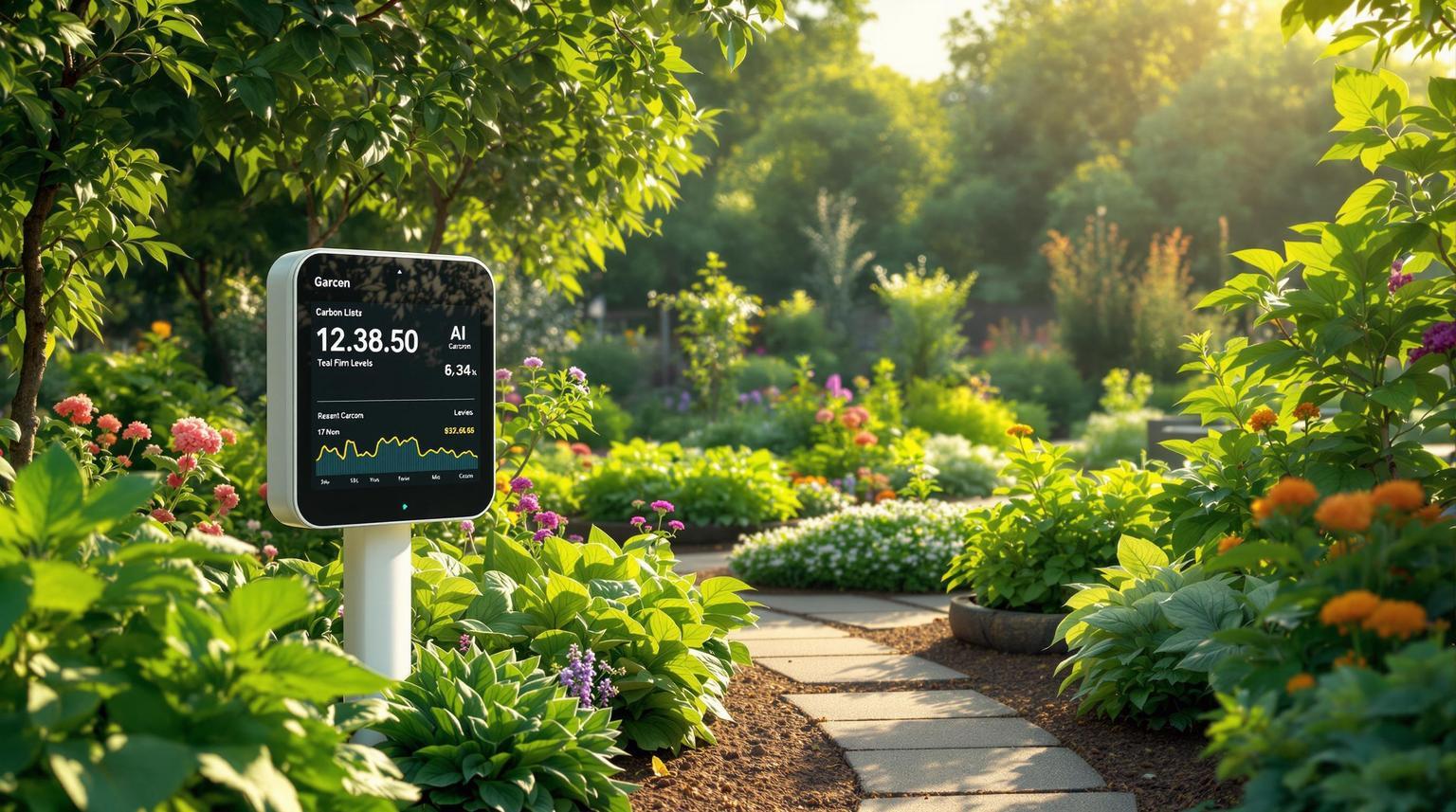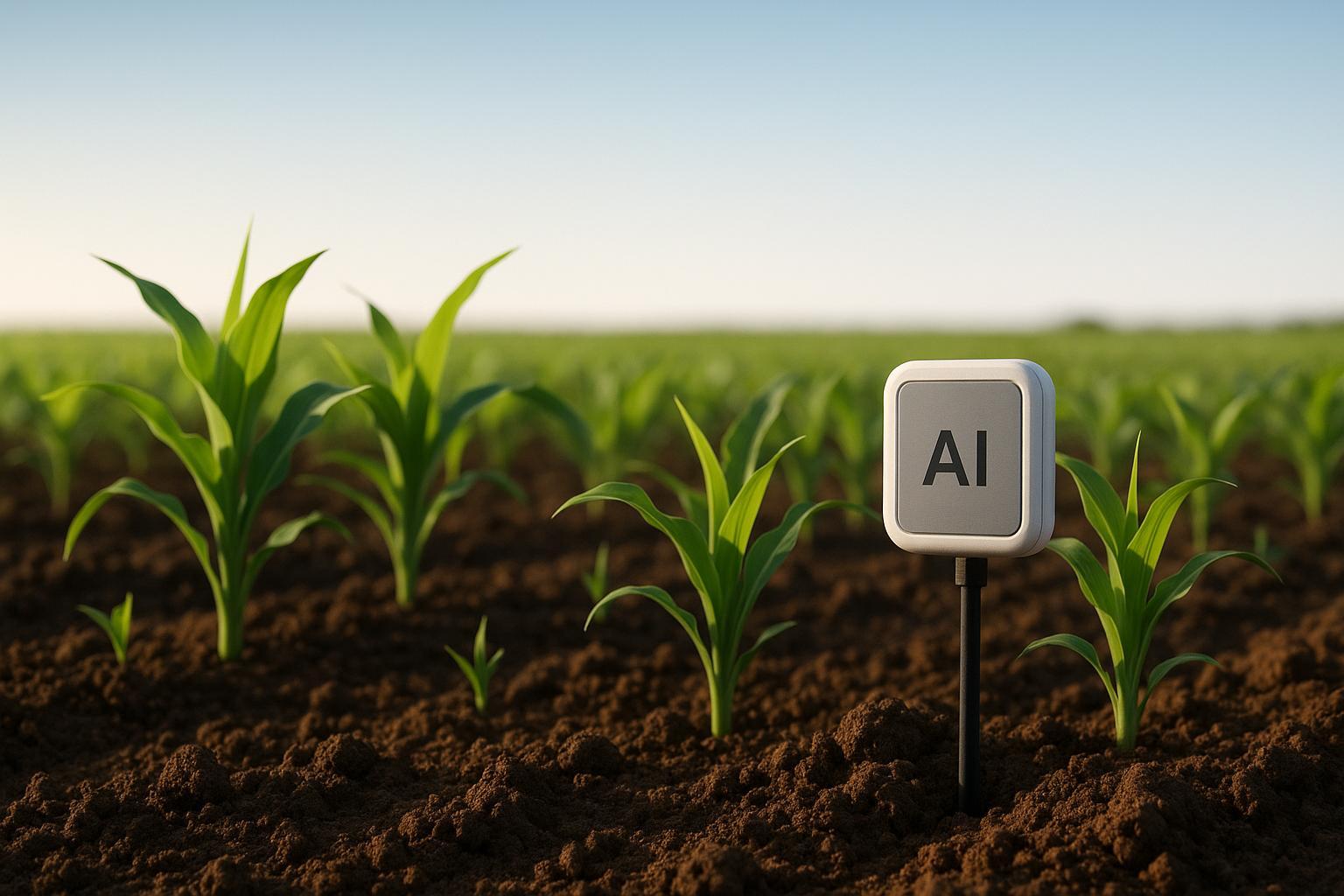AI Sensor Fault Detection for Gardens

AI-driven sensor fault detection ensures your garden's monitoring systems provide accurate, real-time data. Faulty sensors can lead to problems like overwatering, crop loss, or wasted resources. By using machine learning and advanced AI methods, gardeners can identify and resolve sensor issues quickly, preventing disruptions in irrigation, pest control, and disease prevention.
Key insights:
- AI accuracy: Models like Random Forest achieve up to 96.5% accuracy for detecting sensor faults in hydroponic systems.
- Common sensors: Includes soil moisture, temperature, acoustic, and hyperspectral sensors for monitoring plant health and detecting pests or diseases.
- Benefits: Early detection reduces crop losses by up to 40% and saves energy costs in greenhouses.
- Setup essentials: Combine IoT sensors with AI platforms, preprocess data, and enable real-time alerts for effective fault detection.
AI fault detection not only improves garden management but also minimizes costs and maximizes plant health. With the right tools and setup, you can maintain reliable systems and make informed decisions for your garden.
Smart Indoor Plant Care with Home Assistant & AI: Never Kill a Plant Again!

Main Sensors Used for Garden Pest and Disease Management
Smart gardening systems rely on a variety of sensors to monitor plant health and supply critical data for AI-driven fault detection.
Sensor Types and Their Roles
These sensors provide precise data, enabling AI systems to identify issues and maintain ideal garden conditions.
Image sensors play a key role in modern pest detection. These low-power devices capture images of trap contents and send them to control stations for analysis. This eliminates the need for manual trap inspections, offering real-time monitoring over large areas [3][4]. AI-powered pheromone traps are particularly effective, addressing the $220 billion in annual agricultural losses caused by pests worldwide [5].
Acoustic sensors detect the sounds of insects, providing early warnings of infestations. This is especially helpful for identifying flying insects before they cause visible damage. However, their accuracy drops in rainy or windy conditions, making them more effective in covered growing spaces [4].
Thermography sensors use infrared technology to measure temperature differences on plant surfaces. These sensors can identify pathogen infections before visible symptoms emerge by detecting subtle changes in leaf and canopy temperatures [3]. While highly sensitive, they require stable environmental conditions and cannot pinpoint specific pathogens.
Leaf Area Index (LAI) sensors focus on chlorophyll levels, identifying early pest damage through signs of chlorophyll loss caused by insect feeding. Similarly, fluorescence sensors detect changes in chlorophyll fluorescence, signaling potential pathogen presence. However, these are limited to plants containing chlorophyll [3][4].
For large-scale monitoring, hyperspectral sensors mounted on drones scan wavelengths between 350 and 2,500 nanometers. These sensors identify biochemical changes in plants caused by infections, making them ideal for surveying extensive garden areas [3].
Commercial pest management also benefits from sensor advancements. For instance, digital rodent control systems utilize algorithms to predict rodent populations by analyzing detection patterns [5]. Additionally, infrared-based systems provide real-time alerts, enabling immediate responses [5].
Studies indicate that early pest detection can cut yield losses by 20–40% [3], while AI-powered disease identification apps boast recognition rates of up to 98% accuracy [1].
These sensor technologies align with U.S. standards, ensuring seamless integration into local gardening systems.
U.S. Measurement Standards for Gardens
In the United States, garden sensors are calibrated to familiar imperial units, making data interpretation straightforward for gardeners.
- Temperature sensors report in Fahrenheit, simplifying the assessment of heat stress or optimal growing conditions.
- Rainfall and irrigation sensors measure precipitation in inches, aligning with National Weather Service data and local forecasts. This helps gardeners synchronize watering schedules with regional weather patterns.
Soil moisture sensors often display data as volumetric water content percentages or in inches of available water. However, soil characteristics can impact accuracy. For example, bulk density variations between 0.8 and 1.8 g/cm³ can alter water content readings by approximately 0.05 m³/m³, emphasizing the need for proper calibration [6].
Dr. Gaylon S. Campbell highlights the importance of calibration:
"Irrigation scheduling in agriculture and turf requires a soil moisture sensor that is accurate, reliable, and low-cost." [6]
Dielectric sensors, commonly used for soil moisture monitoring, measure the soil's bulk dielectric permittivity rather than water content directly. Accurate readings require calibration to link these measurements to actual water content [6].
When choosing sensors for U.S. gardens, time domain sensors are considered more precise than frequency domain models, though they come at a higher cost. Capacitance sensors operating at lower frequencies are less prone to errors caused by bound water, making them versatile for different soil types [6].
Regular calibration is crucial for maintaining sensor accuracy, particularly in environments with temperature fluctuations or varying salinity levels. Sensors that allow adjustments for soil-specific properties deliver the most reliable data for AI-driven monitoring systems.
AI Methods for Finding Sensor Faults
Accurate sensor data is the backbone of effective garden pest and disease management, making AI-driven fault detection a game-changer. By automating the monitoring process, AI identifies problems early - often before they visibly affect your plants. This proactive approach ensures healthier gardens while reducing the need for constant manual checks. Let’s dive into the specific AI methods that make this possible.
Common AI Detection Methods
Machine learning algorithms are the core of modern sensor fault detection. These systems learn patterns of normal sensor behavior and flag deviations, helping to catch issues quickly.
Supervised learning techniques, like Support Vector Machines (SVMs) and Random Forest, rely on labeled training data to classify sensor readings as normal or faulty. For example, Random Forest achieves an impressive 93.7% accuracy for electrical conductivity sensors and 96.5% for pH sensors in hydroponic setups [2].
Unsupervised learning methods shine when fault data isn’t labeled. Algorithms like One-Class SVM and Local Outlier Factor (LOF) identify anomalies by analyzing what normal operation looks like [7].
Deep learning networks take this a step further by uncovering complex patterns in sensor data. Models such as Convolutional Neural Networks (CNNs) and Recurrent Neural Networks (RNNs) excel at detecting subtle faults that simpler methods might miss.
Artificial Neural Networks (ANNs) also deliver strong results, achieving 93.2% accuracy for electrical conductivity fault detection using only environmental and operational variables [2].
Signal processing techniques complement these approaches by extracting fault signatures from raw sensor signals. Tools like time-frequency analysis and wavelet transforms can pinpoint specific issues. When combined with machine learning, these methods achieve up to 98% accuracy in motor applications [7].
How AI Analyzes Sensor Data
The effectiveness of AI fault detection lies not just in the choice of methods but also in how the system handles and evaluates data. Here’s a closer look at the process:
- Data preprocessing ensures clean and consistent sensor readings by removing noise, filling gaps, and standardizing measurements. This step is vital for accurate analysis, regardless of the sensor type or manufacturer.
- Pattern recognition is where AI models shine. They compare current sensor data against learned baselines, uncovering nonlinear relationships among variables like temperature, moisture, and pH. These models often outperform traditional methods like linear regression in identifying complex correlations.
- Anomaly classification helps distinguish true sensor faults from normal variations caused by environmental factors, seasonal changes, or operational quirks. For instance, a temperature sensor might show unusual readings during a heat wave but still be functioning correctly.
- Real-time alerts keep gardeners informed the moment a fault is detected. The system prioritizes alerts based on severity, ensuring critical issues get immediate attention while minor problems are flagged for later maintenance.
- Predictive analysis takes things further by forecasting potential sensor failures. Research shows machine learning can cut equipment downtime by 30% through predictive maintenance [7].
To ensure seamless performance, the system uses data buffering techniques to handle temporary communication glitches and reduce delays. Optimized algorithms keep things running smoothly, even with multiple sensors feeding data simultaneously [7].
Continuous learning is another key feature. As the system gathers more data, it adapts to seasonal changes and evolving garden conditions, improving accuracy over time.
Lastly, quality monitoring ensures the reliability of the entire system. Regular evaluations check data accuracy, completeness, and consistency, identifying areas for improvement to maintain high detection standards [7].
sbb-itb-4d6a8dd
🚀 Ready to Reinvent Your Garden?
Join thousands of homeowners who have transformed their gardens using our AI design tool. Upload one photo to explore endless possibilities.
Get your AI garden designs →Setting Up AI Fault Detection in Your Garden
Setting up AI fault detection in your garden can be simpler than you think. With some basic hardware and the right steps, you can create a system that keeps your sensors working properly and your plants thriving. Start with a solid setup and expand as needed.
Step-by-Step AI Fault Detection Process
- Integrate sensors and collect data. Many garden sensors require a bridge to connect with AI systems. For instance, the ESP32 microcontroller is often used to gather data from sensors like soil moisture, temperature, rainfall, and water flow. This data is then sent to an IoT platform for monitoring and long-term analysis [8].
- Design a flexible system. Create a system that can operate in manual, automatic, and AI-driven modes, giving you the flexibility to adapt as needed [8].
- Preprocess and normalize data. Sensor data often comes in various formats and scales. Set up routines to clean, fill gaps, and standardize the data so the AI can analyze it accurately [8].
- Enable continuous data collection. Configure your sensors to send regular updates. This ensures the AI system can quickly spot anomalies as they occur [9].
- Set up automated alerts. Program your system to notify you immediately when a fault is detected. Quick action can prevent plant stress or damage [9].
- Train AI models with historical data. Use past sensor readings to teach your AI models what normal conditions look like. This helps the system identify unusual patterns more effectively [8].
- Test under different conditions. Before fully relying on the system, test it thoroughly to ensure it’s stable, accurate, and responsive in various scenarios [8].
Once your system is up and running, follow these tips to keep it performing at its best.
Tips for Reliable System Performance
- Prioritize data quality. Reliable fault detection starts with accurate data. Regularly calibrate your sensors according to the manufacturer’s guidelines and keep them clean to maintain precision [9].
- Incorporate AI insights into your maintenance routine. Use the information from your AI system to enhance your regular garden care practices [9].
- Train your team to respond effectively. Equip your maintenance team with a guide that explains common faults and how to address them. This ensures quick and efficient responses to alerts [9].
- Use advanced analysis techniques. Machine learning and deep learning methods can improve fault detection as they process more data specific to your garden [9].
- Start small and scale up. Begin with essential sensors, such as those monitoring soil moisture and temperature. As your system proves reliable, you can add more sensors to expand its capabilities [9].
- Keep an eye on system performance. Regularly review the system’s output to spot areas for improvement and ensure both the sensors and AI algorithms remain dependable over time [9].
AI Sensor Fault Detection Method Comparison
Choosing the right AI method is key to catching faults early and maintaining the health of your garden or plant system. Different approaches shine in different scenarios, so understanding their strengths can help you create a more dependable monitoring setup.
Detection Method Performance Comparison
AI fault detection methods vary in performance. Generally, machine learning models tend to outperform rule-based systems in terms of accuracy, though they may require more computational power and expertise.
| Method | Accuracy Rate | Computational Requirements | Integration Complexity | Best Use Case |
|---|---|---|---|---|
| CatBoost | 98% for normal/faulty detection; 97% for fault classification | High | Moderate | Large gardens with diverse sensor data |
| Support Vector Machine (SVM) | 96% for normal/faulty detection; 95% for fault classification | Moderate | Moderate | Medium gardens handling high-dimensional data |
| Logistic Regression | 93% for normal/faulty detection; 92% for fault classification | Low | Easy | Small gardens needing clear, explainable results |
| Random Forest | 93.7% for EC sensors; 96.5% for pH sensors | Moderate | Easy | Hydroponic systems and nutrient monitoring |
CatBoost is particularly effective for handling large, mixed datasets, such as those that include plant types, growth stages, and weather conditions [10]. SVM stands out for its ability to analyze complex relationships between variables, making it a good fit for datasets combining soil moisture, temperature, humidity, and light levels [10]. Logistic regression, while not as accurate as other methods, is valued for its simplicity and transparency - perfect for straightforward fault detection [10]. For hydroponic systems, Random Forest has demonstrated exceptional accuracy, particularly with pH sensors, achieving 96.5% accuracy in controlled conditions [12].
These metrics can help you decide on the best method based on the size of your garden and the complexity of your sensor data.
Picking the Right Method for Your Garden Setup
Your garden’s size, data needs, and monitoring goals are central to choosing the right AI fault detection method. For small gardens with basic sensors, methods like logistic regression or simpler rule-based systems are easy to implement and troubleshoot.
For medium-sized gardens with 10–50 sensors, SVM or Random Forest strikes a balance between handling complex data and maintaining computational efficiency. Random Forest, in particular, has proven reliable for hydroponic setups, especially for pH monitoring, where it delivers high fault detection accuracy [12].
Large-scale commercial gardens often need more advanced tools like CatBoost or ensemble methods. These methods can process hundreds of sensor readings at once and adjust to seasonal variations. While they require more computational power, they can significantly reduce false alarms - up to 50% - and improve response times by as much as 60% [11].
Another consideration is your technical expertise. Advanced machine learning models often act as "black boxes", making them harder to troubleshoot compared to the transparency of rule-based systems. Additionally, machine learning approaches usually need extensive historical sensor data - often several months' worth - for effective training. Finally, ensure your chosen method integrates well with your existing garden management software or IoT platform to streamline setup and reduce maintenance efforts.
Conclusion: Improving Garden Systems with AI Fault Detection
AI-driven sensor fault detection is transforming modern gardening by ensuring decisions about irrigation, fertilization, and pest control are based on accurate, real-time data, not corrupted or unreliable sensor readings [13].
These systems work continuously, adapting to changing conditions without the need for manual recalibration [13]. This means your garden monitoring setup can adjust naturally to seasonal shifts and the growth stages of your plants. Such flexibility ensures that monitoring remains precise and uninterrupted.
With real-time monitoring and quick response capabilities, AI systems can detect issues like a malfunctioning soil moisture sensor or an inconsistent temperature probe and immediately compensate by using data from nearby sensors [28,30]. This rapid detection and adjustment prevent larger problems, such as overwatering, nutrient deficiencies, or unchecked pest outbreaks.
On top of improved performance, AI fault detection can lead to noticeable cost savings. By catching issues early, it minimizes crop loss and avoids wasting resources like water and fertilizers [15]. For home gardeners, this means healthier plants and better harvests with less waste. Commercial growers also benefit from steady yields and more efficient resource use [13].
This technology aligns with the broader Industry 4.0 movement, which is bringing advanced IoT and AI innovations into agriculture and home gardening [14]. As IoT sensors become more affordable and AI algorithms advance, these systems are becoming accessible to everyone - from backyard hobbyists to commercial greenhouse operators.
When choosing an AI-powered garden management system, look for platforms that provide detailed data analysis, adaptive learning, and real-time monitoring [27,30]. These features will help you maintain efficiency and address issues promptly.
For more information on how AI can enhance your garden management, visit AIGardenPlanner.
FAQs
How does AI detect faulty sensor readings in garden systems and differentiate them from natural environmental changes?
AI leverages machine learning algorithms and real-time data analysis to pinpoint faulty sensor readings in garden systems. By examining patterns and comparing current data against historical trends, it can distinguish between actual environmental changes - like shifts in temperature or humidity - and errors caused by malfunctioning sensors.
These systems also incorporate sophisticated models to account for natural environmental fluctuations. This ensures the data remains reliable, enabling gardeners to manage pests and diseases effectively. As a result, plants can stay healthy and flourish without being affected by misleading sensor errors.
How can I set up an AI-based system to detect sensor faults in my home garden, and what equipment do I need?
Setting up an AI-powered fault detection system for your home garden might sound complex, but it boils down to a few key steps. Start by installing essential sensors like soil moisture sensors, temperature monitors, pH sensors, and water flow meters. These gadgets gather real-time information about your garden's conditions, such as soil quality, temperature fluctuations, and how well your irrigation system is working.
Once the sensors are in place, connect them to a cloud-based AI platform. Using machine learning, this platform examines the collected data, looking for anything unusual - like inconsistent moisture levels or unexpected drops in water pressure - that might signal a problem with your sensors or irrigation system.
Here’s what you’ll need to set up the system:
- Sensors for soil moisture, pH, and temperature
- Water flow meters to track irrigation
- Environmental monitors for overall garden conditions
- A data hub that links to an AI analysis tool
With this system, you’ll have accurate, real-time insights into your garden, making it easier to tackle pests, diseases, and irrigation issues before they become bigger problems.
How does AI help save costs and improve resource efficiency in garden management for home gardeners and commercial growers?
AI makes garden management easier by taking over tasks like keeping track of soil conditions, weather changes, and plant health. This not only cuts down on labor but also helps use resources like water, fertilizers, and energy more efficiently.
It can also spot problems early, such as faulty sensors or irrigation issues, which helps avoid waste and prevents overuse of resources. For home gardeners and commercial growers alike, these improvements mean healthier plants, lower costs, and less strain on the environment.
🎨 Visualize Your Dream Garden Today!
Transform any outdoor space into a professional landscape design in minutes. Just upload a photo, choose your style, and let our AI do the rest.
Start your garden transformation now →Related posts
Related Articles

How Calibration Impacts Monitoring Accuracy
Effective calibration of monitoring tools is essential for accurate data, reducing pesticide use, and ensuring healthy crop management.

AI Pest Detection in Video Feeds
Learn how AI pest detection systems enhance crop management through real-time monitoring, reduced pesticide use, and actionable insights for farmers.

AI Tools for Regional Climate Data in Gardening
Explore how AI tools transform gardening by using regional climate data for personalized planting, efficient water management, and pest prediction.

AI Tools for Carbon Sequestration in Gardens
Explore how AI tools can transform your garden into a carbon-sequestering powerhouse with smart plant selection and real-time monitoring.

Effective and Safe Methods to Eliminate Ants in Your Garden Without Harming Plants
Discover natural remedies and preventative measures to get rid of ants in your garden without causing harm to your plants. Find out how to control ant populations effectively and safely.

AI for Soil Water Retention Analysis
Explore how AI is revolutionizing soil water retention analysis, optimizing irrigation, and aiding in drought-resistant plant selection for sustainable gardening.